A New Approach to 3D Printing a Yacht Hull Mold
Thermwood recently printed several sections from a 51 foot long yacht hull mold to demonstrate how only a single mold may be needed for the manufacture of larger vessels, such as yachts.
The printed sections of this test mold are made of carbon fiber reinforced ABS from Techmer PM. ABS was chosen because of its physical properties and relatively low cost compared to other reinforced thermoplastics.
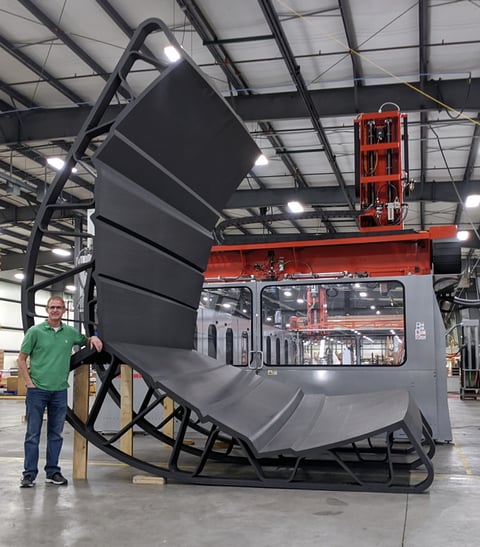
The Story Up to Now:
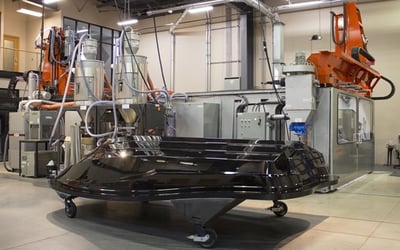 Thermwood has already 3D printed a full size pleasure boat master pattern which has been used to produce multiple production boat hull molds. While this demonstrated the value of additive manufacturing small boat tooling, much larger vessels, yachts for example, require a different approach. In these instances, since only a single mold is needed, it is desirable to print the mold itself rather than print a plug or pattern from which multiple production molds can be made.
Thermwood has already 3D printed a full size pleasure boat master pattern which has been used to produce multiple production boat hull molds. While this demonstrated the value of additive manufacturing small boat tooling, much larger vessels, yachts for example, require a different approach. In these instances, since only a single mold is needed, it is desirable to print the mold itself rather than print a plug or pattern from which multiple production molds can be made.
The Demonstration:
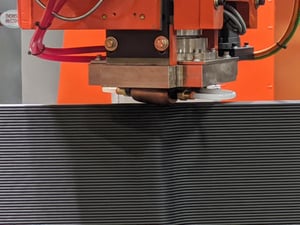 To demonstrate to the industry how this might work, Thermwood printed a 10 foot section from a 51 foot long yacht hull mold. This rather unique mold design was specifically developed for additive manufacturing. It is printed in sections, each about five foot tall. These printed sections are then bound together both chemically and mechanically using high strength polymer cables into two mold halves. The two mold halves then bolt together to form a complete female mold for the yacht hull.
To demonstrate to the industry how this might work, Thermwood printed a 10 foot section from a 51 foot long yacht hull mold. This rather unique mold design was specifically developed for additive manufacturing. It is printed in sections, each about five foot tall. These printed sections are then bound together both chemically and mechanically using high strength polymer cables into two mold halves. The two mold halves then bolt together to form a complete female mold for the yacht hull.
The Process:
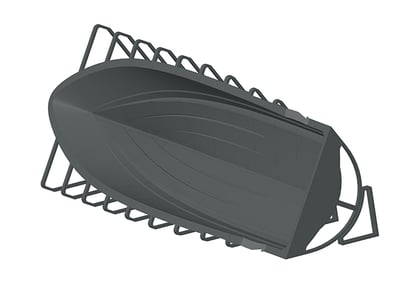 There are several interesting aspects to this design. First, each mold section has a molded in rocker. When the mold is fully assembled, it rests on the floor on these rockers. At this point, the mold can be rolled over to tilt about 45 degrees to either side, kind of like a giant rocking chair. This allows for easier access during the layup process. A set of molded wedges are clamped to the rockers to hold the mold in the desired position. Once the hull has been laid up and fully cured, the mold is rolled to level and the printed wedges are clamped to both sides, holding them level. Then the two mold sides can be un-bolted and slid apart to release the finished boat hull.
There are several interesting aspects to this design. First, each mold section has a molded in rocker. When the mold is fully assembled, it rests on the floor on these rockers. At this point, the mold can be rolled over to tilt about 45 degrees to either side, kind of like a giant rocking chair. This allows for easier access during the layup process. A set of molded wedges are clamped to the rockers to hold the mold in the desired position. Once the hull has been laid up and fully cured, the mold is rolled to level and the printed wedges are clamped to both sides, holding them level. Then the two mold sides can be un-bolted and slid apart to release the finished boat hull.
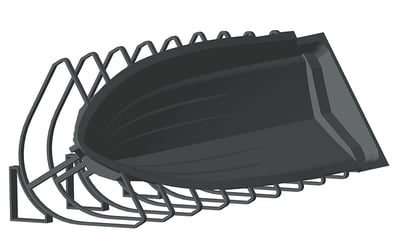
The test pieces Thermwood printed show that this approach will work in practice. The printed sections of this test mold are made of carbon fiber reinforced ABS from Techmer PM. ABS was chosen because of its physical properties and relatively low cost compared to other reinforced thermoplastics.
Certain thermosets will work directly on the ABS molded surface using just traditional mold release practices, however, other thermoset materials are based on solvents that can chemically attack the ABS polymer.
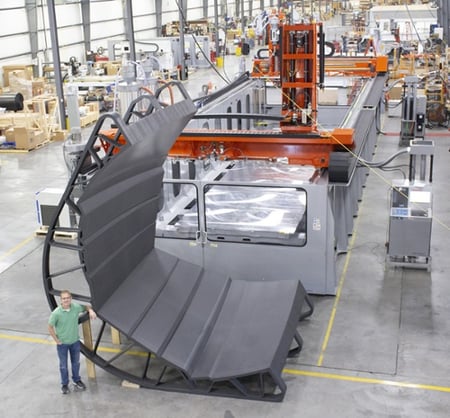
To prevent this, Thermwood has experimented with several protective coatings including traditional mold gel coats. While virtually all coatings tested worked at room temperature, large thermoset molds often experience some heat as a result of the exothermic reaction that occurs during the thermoset curing process. Thermwood tested each of the coatings at 200oF and found that some worked at both room and elevated temperature, while others that worked at room temperature did not work well at the elevated temperature.
While it appears that this approach will work today for certain thermosets, the ideal would be to develop a low cost polymer that is chemically resistant to the other thermoset solvents and eliminate the need for a protective coating.
Fine Details:
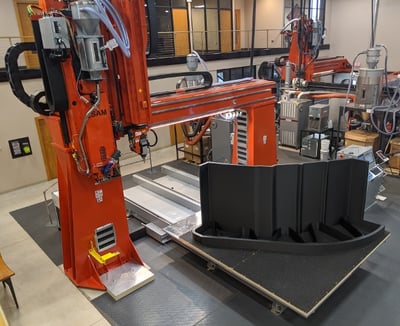 These demonstration pieces were printed and trimmed on a Thermwood LSAM MT 1010, which featured a 10'x10' envelope with a single gantry with both print and trim capabilities. The entire mold section, made of four printed pieces, weighs 4,012 pounds and required 65.5 hours to print. The initial idea was to use this as the centerpiece of Thermwood’s additive manufacturing trade show presentation, however, with the cancellation of trade shows, it has become more of a showpiece for visitors and prospective customers at Thermwood.
These demonstration pieces were printed and trimmed on a Thermwood LSAM MT 1010, which featured a 10'x10' envelope with a single gantry with both print and trim capabilities. The entire mold section, made of four printed pieces, weighs 4,012 pounds and required 65.5 hours to print. The initial idea was to use this as the centerpiece of Thermwood’s additive manufacturing trade show presentation, however, with the cancellation of trade shows, it has become more of a showpiece for visitors and prospective customers at Thermwood.
The Bottom Line:
This demonstration shows that, if you need a really large part, you don’t necessarily need a really large machine. With a little imagination and some creative engineering, really large structures can be made, even on smaller, lower cost additive manufacturing systems. While the LSAM MT is not all that small, it does fit the needs of a lot of companies who would like to make larger parts but can’t quite handle Thermwood’s really large systems.

